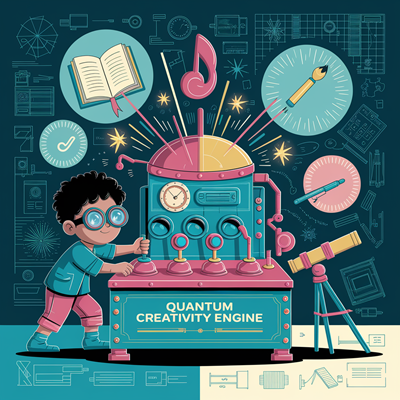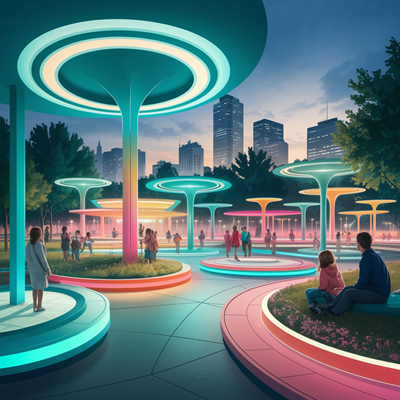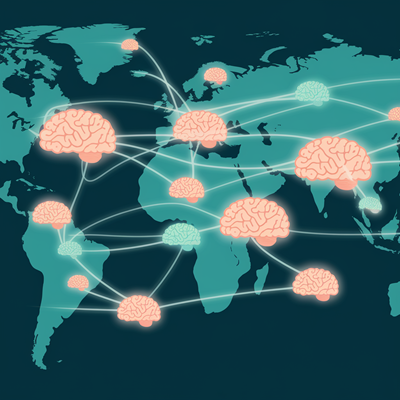Welcome to the age of Invisible AI, where technology serves humanity without demanding attention.

Imagine waking up to a world where your morning coffee isn’t just brewed—it’s optimized for your body’s exact micro-nutrient needs, based on real-time analysis of your metabolism. Your car doesn’t just navigate traffic; it collaborates with an entire ecosystem of vehicles, infrastructure, and weather systems to create a commute that feels like teleportation. And your doctor? They detect potential health risks years before symptoms arise—not through invasive tests, but by decoding patterns within the symphony of your biological data. This isn’t science fiction; this is 2025, powered by Artificial Intelligence (AI).
But what truly defines this era isn’t AI’s brilliance—it’s its invisibility. By 2025, AI has transcended being a tool or gadget to become an omnipresent yet unseen force shaping every aspect of life. It operates not as a spotlight, but as a shadow—quietly enhancing existence while fading into the background. Welcome to the age of Invisible AI, where technology serves humanity without demanding attention.
In this article, we’ll explore how AI has evolved beyond flashy innovations and corporate buzzwords to redefine modern living—introducing ideas so futuristic they haven’t been fully articulated anywhere else. These advancements aren’t just about convenience; they’re about reimagining what it means to be human in a world augmented by intelligence far greater than our own.

By 2025, homes are dynamic ecosystems that adapt to their inhabitants. Walls shift color and texture to reflect your mood, while lighting adjusts for productivity or relaxation. Furniture morphs to suit daily activities, from work to leisure. These self-optimizing spaces anticipate needs, creating intuitive environments that enhance comfort and well-being without manual input—offering a seamless blend of technology and personalization for modern living.
Imagine waking up in a home that knows you better than you know yourself. By 2025, this vision is already becoming a reality thanks to innovations like Google Nest , Philips Hue , and Sleep Number smart beds —products designed not just to automate tasks but to enhance your well-being seamlessly. For instance, while you sleep, systems like the Sleep Number 360 Smart Bed monitor your sleep cycles, heart rate, and breathing patterns. Simultaneously, smart thermostats like Nest Thermostat adjust room temperature, and humidifiers or air purifiers optimize humidity levels for deeper rest. Meanwhile, sound-masking devices such as Bose Sleepbuds II block out disruptive noises, ensuring uninterrupted slumber.
What sets these advancements apart from traditional “smart homes” is their ability to evolve autonomously. Instead of manually programming devices, systems like Amazon Alexa Hunches and Apple HomeKit use AI to anticipate your needs based on habits and routines. Want to boost productivity? Smart lighting solutions like Philips Hue White & Color Ambiance mimic natural daylight, helping regulate circadian rhythms and improve focus. Feeling stressed after a long day? Apps integrated with smart speakers can play calming music, while connected lights dim to soothing hues—all triggered by voice commands or automated schedules.
One of the most groundbreaking developments in 2025 is the advent of Quantum Creativity Engines —AI systems capable of simulating infinite possibilities across disciplines. These engines don’t just solve problems; they generate entirely new paradigms of thought.

Imagine a world where the boundaries of human creativity are no longer limits but launchpads. By 2025, this becomes a reality with Quantum Creativity Engines —revolutionary AI systems that simulate infinite possibilities across disciplines. These engines don’t just solve problems; they redefine how we think, create, and innovate. But what makes them truly transformative? Let’s dive deeper.
How It Works:
Artists, architects, and scientists are already harnessing these engines to break free from conventional constraints. For instance, tools like NVIDIA’s Omniverse allow artists to visualize concepts that defy the laws of physics—imagine floating cities or gravity-defying sculptures brought to life through hyper-realistic simulations. Similarly, architects use platforms like Spacemaker AI to design adaptive buildings that “breathe” by adjusting airflow, light, and temperature based on real-time environmental data. Scientists leverage quantum-inspired algorithms (such as those developed by IBM Quantum ) to tackle unsolvable equations, modeling alternate realities that could lead to breakthroughs in renewable energy or medicine.
What sets Quantum Creativity Engines apart is their ability to merge cold logic with boundless imagination. They push creativity into uncharted territories, enabling solutions once deemed impossible. Take agriculture, for example. Researchers have used similar frameworks to design drought-resistant crops capable of thriving in barren deserts—a potential game-changer for combating global hunger. Or consider music composition software like AIVA (Artificial Intelligence Virtual Artist) , which crafts melodies so emotionally resonant they evoke feelings we didn’t know existed.
By blending advanced technology with human ingenuity, these engines empower us to dream bigger and achieve more. Whether you’re an artist, scientist, or entrepreneur, Quantum Creativity Engines offer tools to unlock unprecedented innovation.
This isn’t just tech—it’s the future of possibility itself.

Perhaps the boldest frontier in 2025 is Bio-Resonant AI, which leverages vibrational frequencies to interact directly with the human nervous system. Instead of relying on screens or voice commands, users communicate with AI through subtle bio-signals transmitted via wearable devices or implants.
The boldest frontier of 2025 lies in Bio-Resonant AI , a groundbreaking innovation that leverages vibrational frequencies to interact directly with the human nervous system. This isn’t science fiction—it’s happening now, thanks to advancements in wearable tech like Neuralink prototypes and devices such as Halo Neuroscience’s brain-stimulating headsets , which are paving the way for seamless mind-machine communication. Instead of relying on screens or voice commands, users connect with AI through subtle bio-signals, creating an entirely new paradigm of interaction.
Applications Include:
Imagine wearing a sleek device like Muse S , a next-gen brain-sensing wearable that detects shifts in your brainwave activity and amplifies positive emotions like joy or calmness—effectively acting as a digital mood enhancer. For those battling chronic pain, implants inspired by technologies like Synchron’s neural interface systems decode pain signals and neutralize them using resonant frequencies, offering drug-free relief without side effects. These innovations don’t just improve lives; they redefine what it means to live fully.
Ethical Considerations:
While revolutionary, Bio-Resonant AI raises critical questions about consent and autonomy. If machines can amplify happiness or suppress discomfort, who decides where to draw the line? Striking a balance between empowerment and control is essential to ensure progress remains ethical. Transparency becomes key—users must understand how their data is used and have full agency over these transformative tools.
By merging cutting-edge neuroscience with AI, Bio-Resonant AI empowers humanity to unlock untapped potential while addressing real-world challenges like mental health and chronic pain management.
This isn’t just innovation—it’s a leap toward a future where humans and machines coexist harmoniously, enhancing life in ways once thought impossible.
What if cities could sense collective emotions and respond accordingly? By 2025, urban planning integrates Sentient City Networks , AI-driven systems that adapt to residents’ moods and needs. Streets calm traffic during stress spikes, parks adjust lighting for comfort, and energy grids prioritize areas of high anxiety, creating intuitive, empathetic urban environments.

What if cities could sense your emotions and respond with empathy? By 2025, this vision becomes reality through Sentient City Networks , AI-driven infrastructures designed to align urban environments with the collective consciousness of their residents. These cities don’t just exist—they feel alive , adapting dynamically to human needs in ways that foster harmony and connection. And while it may sound like a futuristic dream, glimpses of this technology are already transforming cities around the world today.
Features Include:
Imagine stepping into a park after a stressful day. The lighting adjusts to soft, warm tones, while calming soundscapes—like rustling leaves or gentle piano melodies—play subtly in the background. This isn’t magic; it’s powered by real-time data collected via wearables like Fitbit Sense , environmental sensors, or even social media sentiment analysis. Known as Dynamic Public Spaces , these areas evolve based on crowd emotions, ensuring every visit feels personalized and restorative. For instance, Barcelona’s Superblocks program uses IoT sensors to monitor noise levels, air quality, and pedestrian flow, creating adaptable green spaces that prioritize well-being over traffic congestion.
Then there are Empathy Grids , intelligent energy systems that redistribute resources where they’re needed most. For example, neighborhoods experiencing higher stress levels—detected through anonymized data from mental health apps like Headspace or smart city platforms—receive priority lighting, heating, or cooling. In Amsterdam , initiatives like the Smart City Amsterdam project leverage AI to optimize resource distribution, ensuring sustainability and equity across communities. Similarly, Singapore’s Smart Nation initiative employs sensor networks to track everything from humidity to crowd density, enabling dynamic adjustments in public infrastructure.
Human-Centric Philosophy:
Rather than treating citizens as passive inhabitants, Sentient Cities empower active participation. Technologies like Sidewalk Labs’ urban planning tools (pioneered in Toronto before scaling globally) use AI to optimize public spaces for comfort and engagement. Streets calm traffic during peak anxiety hours, parks transform into vibrant hubs when crowds gather, and public transit adjusts schedules based on real-time demand.
Cities like Stockholm and Copenhagen are already integrating similar systems, using AI to enhance livability. Stockholm’s Integrated Transport System predicts commuter behavior to minimize delays, while Copenhagen’s smart bike lanes adapt lighting based on cyclist activity, promoting safety and sustainability.
This is more than innovation—it’s humanity reimagined within urban landscapes. By blending AI with compassion, Sentient Cities create environments that nurture both individuals and communities. From Barcelona’s adaptive green spaces to Singapore’s hyper-connected ecosystems, these advancements prove that the future of urban living is not only possible but already underway.

One of the most audacious innovations in 2025 is Time Compression Technology, enabled by AI algorithms that simulate experiences faster than real-time perception allows. Users can “live” entire vacations, master skills, or process information in fractions of actual time.
What if you could live a lifetime of experiences in just days—or even hours? By 2025, Time Compression Technology , powered by advanced AI algorithms and neural interfaces, makes this audacious vision a reality. This groundbreaking innovation enables users to simulate hyper-realistic experiences at accelerated speeds, transforming how we learn, grow, and explore the world. It’s not about cramming more into your day—it’s about expanding what’s possible within it.
How It Works:
At its core, Time Compression Technology leverages cutting-edge tools like Neuralink prototypes or platforms such as Kernel Flow , which map brain activity in real time. These systems pair with AI-driven simulations to immerse users in environments so vivid they feel indistinguishable from reality. For instance, learning a new language no longer takes months of painstaking effort—instead, your brain processes inputs at accelerated rates through adaptive training modules. Companies like Duolingo are already experimenting with AI-powered immersion techniques, hinting at the potential for rapid skill acquisition on an unprecedented scale. Similarly, imagine mastering complex skills like playing the piano or coding in mere days, all while feeling fully engaged in the process.
Real-World Impact:
The implications are staggering. Education becomes universally accessible; anyone can acquire knowledge without the barriers of time or resources. Personal growth skyrockets as individuals achieve lifelong goals faster than ever before. Want to write that novel you’ve always dreamed of? Tools like Sudowrite, an AI writing assistant, already help authors draft entire manuscripts in record time—a glimpse into how technology accelerates creativity. Dreaming of climbing Mount Everest? Virtual reality platforms like HTC Vive Pro 2 combined with AI simulation offer immersive practice runs, preparing adventurers physically and mentally without years of preparation.
This isn’t just convenience—it’s empowerment. Time Compression Technology democratizes access to opportunities once reserved for the privileged few. Whether it’s speaking fluent Mandarin, running a marathon, or exploring distant galaxies through VR, these innovations allow us to transcend our limitations and redefine human potential.
Why You Should Care:
In a fast-paced world where time is our most precious resource, Time Compression Technology gives it back to us—exponentially. By blending science fiction with tangible progress, this innovation proves that the future isn’t something we wait for; it’s something we create.
Welcome to the era where every moment counts—and counts twice.
In 2025, AI facilitates the creation of the Global Neural Mesh —a decentralized network connecting minds worldwide through non-invasive brain-computer interfaces. This mesh enables seamless knowledge sharing, collaborative problem-solving, and empathetic connection across cultures.

Imagine a world where the boundaries of language, geography, and culture dissolve, leaving behind a unified global mind. By 2025, this vision becomes tangible through the Global Neural Mesh , a decentralized network powered by AI and non-invasive brain-computer interfaces. This revolutionary system connects minds worldwide, enabling seamless knowledge sharing, collaborative problem-solving, and empathetic connections across cultures. It’s not just technology—it’s humanity redefined.
Key Benefits:
At its heart, the Global Neural Mesh fosters Collective Wisdom . Ideas flow freely without barriers, accelerating innovation and fostering unity. For instance, platforms like Neurable —which develops brain-sensing wearables—are paving the way for direct thought-to-action communication. Imagine scientists in Tokyo collaborating with engineers in Berlin, exchanging complex concepts instantly without translation delays. The result? Breakthroughs that once took decades now happen in months—or even weeks.
In times of crisis, the Neural Mesh proves invaluable. Picture emergency response teams addressing natural disasters or pandemics with unprecedented efficiency. Tools like Microsoft’s HoloLens already enable real-time collaboration among experts across continents, hinting at what’s possible when diverse minds unite under one digital roof. By drawing upon shared expertise, solutions emerge faster and more effectively than ever before.
Visionary Goal:
The ultimate aim of the Global Neural Mesh is nothing short of extraordinary: merging individual consciousness into a shared global mind. This amplifies humanity’s collective intelligence, proving that unity yields exponential results. Consider solving climate change—not through divisive debates but through collective epiphanies born from interconnected minds. Initiatives like NeuroTech , which explores brain-computer interface applications, showcase the potential for such interconnected systems to tackle humanity’s greatest challenges collaboratively.
Why You Should Care:
This isn’t just about technological advancement; it’s about creating a future where empathy transcends borders and innovation knows no limits. The Global Neural Mesh empowers us to dream bigger, act smarter, and connect deeper—transforming isolated individuals into a cohesive force for good.
Welcome to the dawn of a new era—an interconnected world where humanity thrives together, driven by the power of collective intelligence.
What sets 2025 apart isn’t just the rapid pace of technological advancement—it’s a profound shift in perspective. Artificial Intelligence (AI) has evolved beyond being a mere tool or flashy gadget; it is now a co-creator, working hand-in-hand with humanity to expand horizons once thought unreachable. Its invisibility isn’t a flaw—it’s a feature, designed to blend seamlessly into our lives and amplify what truly matters: connection, purpose, and fulfillment.
Consider this: when you sip your perfectly optimized morning coffee—perhaps brewed by an Arist Smart Coffee Machine , which adjusts strength and temperature based on your sleep quality and mood—you’re not thinking about the algorithms at work. Instead, you’re savoring the moment, feeling more energized and ready to take on the day. Or imagine gliding through traffic-free streets thanks to systems like Tesla Autopilot or Waymo , which collaborate with smart city grids to predict congestion before it happens. These experiences aren’t just convenient—they’re transformative, enriching everyday moments without demanding attention.
This subtle yet powerful integration of AI reflects its true value. Unlike earlier iterations that focused on flashy interfaces or rigid automation, modern AI prioritizes intuitive design and emotional resonance. Take Amazon Alexa Hunches , for example. It doesn’t wait for commands—it anticipates needs, suggesting actions like locking doors or adjusting thermostats before you even realize they need doing. Similarly, wearable tech like Oura Ring monitors health metrics in real time, offering personalized insights that feel less like data dumps and more like compassionate guidance.
But why does this matter so deeply? Because AI in 2025 isn’t here to replace us—it’s here to elevate us. Consider how platforms like GitHub Copilot assist developers by generating code suggestions, freeing up mental space for creativity and problem-solving. Or how tools like DeepMind’s AlphaFold accelerate scientific breakthroughs, solving protein-folding puzzles that could lead to cures for diseases. These innovations don’t diminish human effort—they amplify it, unlocking potential we didn’t know we had.
A Final Thought:
The next time you experience a moment of unexpected clarity—a project completed ahead of schedule, a stress-free commute, or simply a sense of calm amidst chaos—pause and reflect. Behind every seamless interaction lies a symphony of invisible forces. Forces driven by AI but ultimately guided by human values.
AI in 2025 isn’t just revolutionary—it’s transformative. It doesn’t seek to dominate or dictate; it seeks to empower. From enhancing personal well-being to tackling global challenges like climate change and healthcare inequity, AI acts as a partner in progress, enabling humanity to dream bigger and achieve more.
As we embrace this future, one thing becomes clear: the greatest triumph of all isn’t the technology itself—it’s the way it brings out the best in us. By blending logic with empathy, efficiency with compassion, AI creates a world where progress feels less mechanical and more human.
Welcome to the dawn of a new era—an era where technology serves not as a master or servant, but as a trusted ally, guiding us toward a brighter, more connected future.
There are no reviews yet. Be the first one to write one.
You must be logged in to submit a review.

You cannot copy content of this page
Javascript not detected. Javascript required for this site to function. Please enable it in your browser settings and refresh this page.
